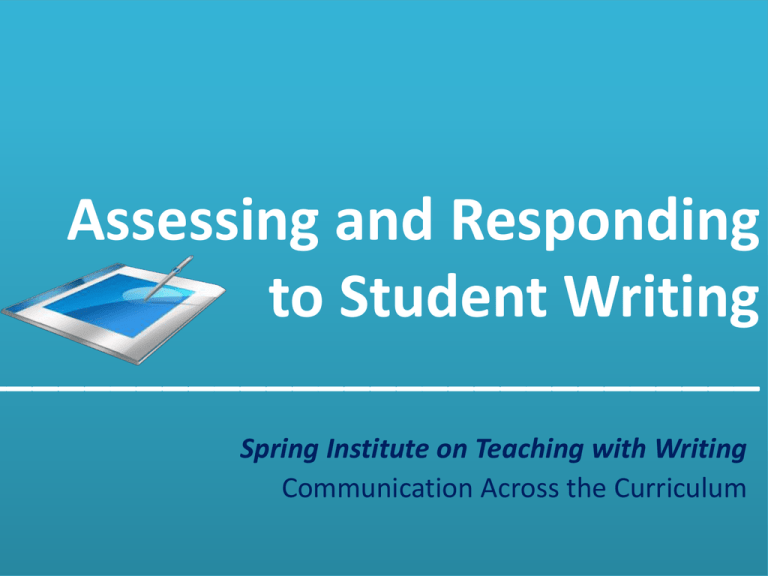Responding to Writing
advertisement

Assessing and Responding to Student Writing ______________________________ Spring Institute on Teaching with Writing Communication Across the Curriculum “Look at this paper! Students these days can’t write at all. Where do I even start?” “Commenting on these drafts is such a chore. It takes hours. How do I possibly keep up?” “Students ignored my comments on the last draft. I see basically the same problems in this new draft. Why do I bother?” Today’s Objective To think strategically about our response to student writing Awareness • your patterns of response • a wider range of approaches • how students interpret/react Choices • the most effective approach, given the assignment, stage of writing, and student ability Exercise 2: Look at the three response styles (a, b, c) in handout 2. • What name would you give each style? • Which is your “go to” approach when working with student drafts? • Why—what are the benefits; what purpose does this kind of commentary serve? The Editor Editor: Benefits/Costs • • • • It’s easier to do it for them It’s satisfying Modeling can help (if you explain WHY) Advanced writers may be able to emulate • It can take a LOT of time • Students feel overwhelmed • Wasted effort if student needs significant content revisions. • Writers will produce “cleaner” text but won’t learn; errors may persist. • Students lose ownership. -RESERVE FOR LATER DRAFTS -EXPLAIN PATTERNS OF ERROR, MODEL, & ASK THEM TO “APPLY THROUGHOUT” -LIMIT TO THREE -USE X NEXT TO LINE I decide on the verdict I insert evaluative labels I expect students to translate my verdict into revisions The Judge Judge: Benefits/Costs • • • • It’s easy, fastest approach It’s satisfying Later, number of comments +/- can justify grade Encourages ownership; YOU figure it out (for advanced writers) • Summative labels suggest writing is “done”, can discourage revision. • Labels often not instructive; they know THAT the text is weak or strong, but not WHERE, WHY, or HOW to revise. -RESERVE FOR FINAL DRAFTS -QUICK EVALUATION WITH ADVANCED WRITER -FOR ASSESSMENT, NOT TEACHING The Process of Revision (Flower et al.) Detect Judge Diagnose ? Apply Strategy Editor The Helpful Reader Helpful Reader: Benefits/Costs • They become aware of the reader, start to internalize the reader • They can better diagnose problems & opportunities • They learn new strategies • They begin to set revision goals -USE WITH NOVICES • Not as helpful for one-draft -USE on 1st DRAFTS -READ WHOLE DOC/SECT papers (unless repeating) • More advanced writers may not need BEFORE COMMENTING -TRY RUBRICS as much explanation. -TRY END COMMENT + A FEW • Becoming a helpful reader takes MARGINAL ONES determination, takes up-front effort. -CONSIDER AUDIO RESPONSE -BEWARE TRACK CHANGES -USE GUIDED PEER REVIEW Exercise 3: Read handout 1 again. -Develop a checklist or rubric to prioritize criteria. Comment as a helpful reader. - Try an end comment with limited marginal comments OR fill in your rubric -Later, try an audio comment or Word’s comment program if you haven’t yet TIPS Beforehand • Give them the rubric WITH the assignment. • Have them develop and test the rubric with you on a sample. When drafts are due in class • Give writers 5 minutes to proof, write 1-P self review on back. • Have a peer check for ONE thing. They should mark instances ; writer should revise. • Do guided peer review or demo on one aspect of the paper. Give writers time to apply before collecting. When you need to reduce the workload • • • • Train PLAs/TAs with rubric; they grade. Spot check. Have students choose 2-3 best pieces & revise for portfolio. Use comments for first draft; points-only rubric + end comment for final. Use cumulative sequence.


